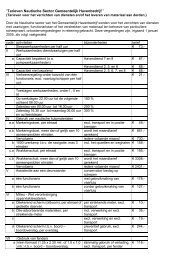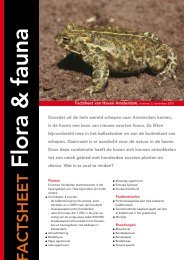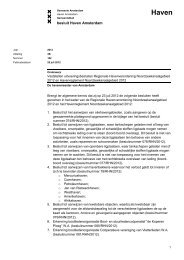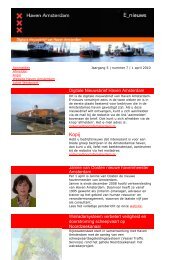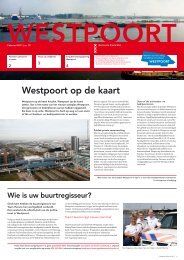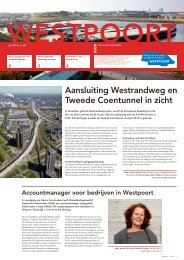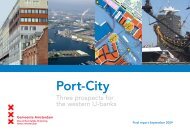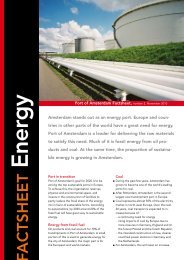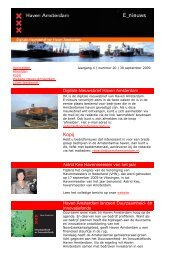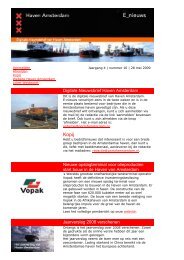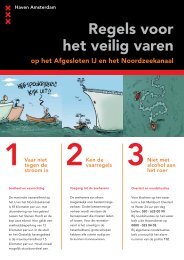Create successful ePaper yourself
Turn your PDF publications into a flip-book with our unique Google optimized e-Paper software.
On the one hand, the Port of Amsterdam must<br />
maintain its competitive strength and retain its<br />
market shares in the healthy profit-generating<br />
goods segments. Only then can it continue to be<br />
an economic engine and provide jobs and revenue.<br />
On the other hand, port-related economic activities<br />
need to take place in a socially responsible and<br />
environmentally friendly manner. In <strong>2006</strong>, the Port<br />
of Amsterdam was active on four fronts: the market,<br />
physical space, better access and sustainability.<br />
The market<br />
In <strong>2006</strong>, the emphasis was very much on strengthening<br />
the Port of Amsterdam as an international<br />
logistics hub, with the aim of maintaining its longterm<br />
competitive strength and providing top-quality<br />
infrastructure and facilities. To that end, Amsterdam<br />
needs a greater number of ships and bigger volumes<br />
of cargo. Greater economies of scale allow us to<br />
charge customers competitive rates for nautical<br />
and logistics services. Likewise, this makes for<br />
attractively priced raw materials and components,<br />
which are used by manufacturing companies in<br />
the port area. Also, greater economies of scale<br />
make it possible to provide efficient and very<br />
frequent services to hinterland destinations.<br />
On many fronts, the Port performed particularly<br />
well in <strong>2006</strong>. The container sector and the energy<br />
business (oil, coal and renewables) in particular<br />
grew strongly. In addition, more ships called at the<br />
Port of Amsterdam.<br />
To serve the rapidly growing Asian market better,<br />
the Port of Amsterdam opened a permanent office<br />
in the Chinese city of Shanghai in <strong>2006</strong>. Since<br />
early <strong>2006</strong>, two container shipping services between<br />
Europe and Japan and China have used the Ceres<br />
Paragon terminal.<br />
In the Hamburg-Le Havre range of ports, the<br />
Amsterdam Ports (the Port of Amsterdam plus<br />
three nearby North Sea canal ports) market share<br />
grew from 7.0% to 7.5%. Equally noteworthy,<br />
Amsterdam Ports has now become the fourthlargest<br />
port in Northwestern Europe.<br />
Physical space<br />
The amount of land leased out by the Port increased<br />
substantially in <strong>2006</strong>. Some 80 hectares (gross)<br />
were allocated to companies active in the port area,<br />
whereas the annual average over the past ten<br />
years had hovered around 25 hectares. The Port<br />
is carefully husbanding its land resources using<br />
various means: utilizing space intensively and<br />
optimally; buying back sites no longer used; as<br />
well as restructuring existing sites. In <strong>2006</strong>, 23.7<br />
hectares of land leased out concerned restructured<br />
sites. Most of this went to Handelsveem in the<br />
Westhaven (13.6 hectares) and Greenmills in the<br />
Hornhaven (9 hectares).<br />
Companies have shown a keen interest in Atlaspark<br />
– the last port section where (dry) land is still<br />
available. In <strong>2006</strong>, the Port began discussions on<br />
the construction of a distribution center in Atlaspark<br />
with the property developer David Hart Vastgoed<br />
Groep, reaching an agreement early 2007.<br />
Better access<br />
An international logistics hub requires very good<br />
infrastructure in terms of quality and capacity.<br />
That applies to both the water-related and the<br />
land-related facilities. In <strong>2006</strong>, much progress<br />
was made in improving the port’s accessibility.<br />
The IJgeul canal was both deepened and extended.<br />
(The IJgeul canal forms the link between the<br />
sea and the North Sea Canal, which runs all the<br />
way to Amsterdam.) Furthermore, much preparatory<br />
work was done to bring forward the decision<br />
to build the much-needed second canal lock in<br />
IJmuiden (where the North Sea Canal discharges<br />
into the sea) from 2008 to the first half of 2007.<br />
In terms of land-based facilities, the Port of<br />
Amsterdam is working hard to make more<br />
intensive use of the existing infrastructure for<br />
transport to and from the hinterland. In doing<br />
so, the Port is moving away from road transport<br />
toward more sustainable modes of transport –<br />
namely barging, short-sea shipping and rail transport.<br />
In <strong>2006</strong>, various services to the hinterland<br />
by inland waterway and rail were made more<br />
frequent and were expanded. On top of that,<br />
AMSbarge was launched: in the northern part<br />
of the Randstad area, a barge sails between the<br />
Port of Amsterdam and companies located along<br />
canals/rivers to pick up and deliver containers.<br />
Finally, Port of Amsterdam, together with the<br />
Port of Rotterdam and ProRail (responsible for<br />
the Dutch rail infrastructure) took a 15% stake<br />
(to a maximum of EUR 3 million) in Keyrail – the<br />
company set up in <strong>2006</strong> to operate the Betuwe<br />
Line, which is a dedicated rail line for goods<br />
transport to the German Border.<br />
Sustainability<br />
In <strong>2006</strong>, the Port of Amsterdam launched many<br />
projects to promote sustainable development.<br />
After all, the Port can only remain a cornerstone<br />
of the regional economy, if it operates in a socially<br />
responsible and environmentally friendly fashion.<br />
The Port of Amsterdam takes a sustainable approach<br />
to land use; the transport of people and goods;<br />
fuel consumption; air quality; (the prevention of)<br />
soil contamination; as well as job creation for a<br />
diversified workforce. One example of sustainable<br />
development is the creation of a large wind farm<br />
in the port area. Further to that, Greenmills will<br />
recycle organic waste flows to produce bio-fuels.<br />
Also, Harvest Energy concluded a contract for the<br />
construction of a bio-ethanol plant in the port area<br />
(also see page 40).



